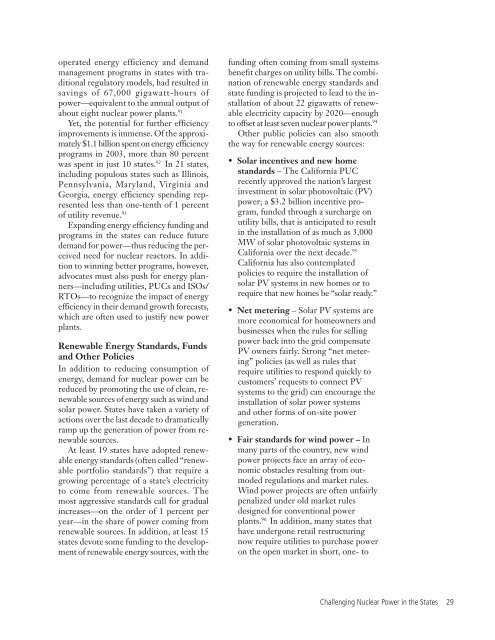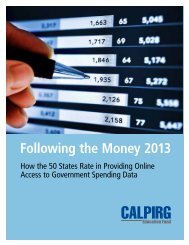Download Report (PDF) - CalPIRG
Download Report (PDF) - CalPIRG
Download Report (PDF) - CalPIRG
Create successful ePaper yourself
Turn your PDF publications into a flip-book with our unique Google optimized e-Paper software.
operated energy efficiency and demand<br />
management programs in states with traditional<br />
regulatory models, had resulted in<br />
savings of 67,000 gigawatt-hours of<br />
power—equivalent to the annual output of<br />
about eight nuclear power plants. 91<br />
Yet, the potential for further efficiency<br />
improvements is immense. Of the approximately<br />
$1.1 billion spent on energy efficiency<br />
programs in 2003, more than 80 percent<br />
was spent in just 10 states. 92 In 21 states,<br />
including populous states such as Illinois,<br />
Pennsylvania, Maryland, Virginia and<br />
Georgia, energy efficiency spending represented<br />
less than one-tenth of 1 percent<br />
of utility revenue. 93<br />
Expanding energy efficiency funding and<br />
programs in the states can reduce future<br />
demand for power—thus reducing the perceived<br />
need for nuclear reactors. In addition<br />
to winning better programs, however,<br />
advocates must also push for energy planners—including<br />
utilities, PUCs and ISOs/<br />
RTOs—to recognize the impact of energy<br />
efficiency in their demand growth forecasts,<br />
which are often used to justify new power<br />
plants.<br />
Renewable Energy Standards, Funds<br />
and Other Policies<br />
In addition to reducing consumption of<br />
energy, demand for nuclear power can be<br />
reduced by promoting the use of clean, renewable<br />
sources of energy such as wind and<br />
solar power. States have taken a variety of<br />
actions over the last decade to dramatically<br />
ramp up the generation of power from renewable<br />
sources.<br />
At least 19 states have adopted renewable<br />
energy standards (often called “renewable<br />
portfolio standards”) that require a<br />
growing percentage of a state’s electricity<br />
to come from renewable sources. The<br />
most aggressive standards call for gradual<br />
increases—on the order of 1 percent per<br />
year—in the share of power coming from<br />
renewable sources. In addition, at least 15<br />
states devote some funding to the development<br />
of renewable energy sources, with the<br />
funding often coming from small systems<br />
benefit charges on utility bills. The combination<br />
of renewable energy standards and<br />
state funding is projected to lead to the installation<br />
of about 22 gigawatts of renewable<br />
electricity capacity by 2020—enough<br />
to offset at least seven nuclear power plants. 94<br />
Other public policies can also smooth<br />
the way for renewable energy sources:<br />
• Solar incentives and new home<br />
standards – The California PUC<br />
recently approved the nation’s largest<br />
investment in solar photovoltaic (PV)<br />
power; a $3.2 billion incentive program,<br />
funded through a surcharge on<br />
utility bills, that is anticipated to result<br />
in the installation of as much as 3,000<br />
MW of solar photovoltaic systems in<br />
California over the next decade. 95<br />
California has also contemplated<br />
policies to require the installation of<br />
solar PV systems in new homes or to<br />
require that new homes be “solar ready.”<br />
• Net metering – Solar PV systems are<br />
more economical for homeowners and<br />
businesses when the rules for selling<br />
power back into the grid compensate<br />
PV owners fairly. Strong “net metering”<br />
policies (as well as rules that<br />
require utilities to respond quickly to<br />
customers’ requests to connect PV<br />
systems to the grid) can encourage the<br />
installation of solar power systems<br />
and other forms of on-site power<br />
generation.<br />
• Fair standards for wind power – In<br />
many parts of the country, new wind<br />
power projects face an array of economic<br />
obstacles resulting from outmoded<br />
regulations and market rules.<br />
Wind power projects are often unfairly<br />
penalized under old market rules<br />
designed for conventional power<br />
plants. 96 In addition, many states that<br />
have undergone retail restructuring<br />
now require utilities to purchase power<br />
on the open market in short, one- to<br />
Challenging Nuclear Power in the States 29




